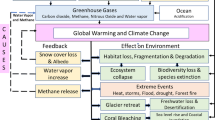Abstract
The results of one year’s monitoring in Srednja Bijambarska Cave (Bosnia and Herzegovina) are presented and discussed. Temporal variations of the carbon dioxide (CO2) concentration are controlled by the switching between two ventilation regimes driven by outside temperature changes. A regression model with a simple perfectly mixed volume applied to a cave sector (“Music hall”) resulted in an estimate of ventilation rates between 0.02 h−1 and 0.54 h−1. Carbon dioxide input per plan surface unit is estimated by the model at around 50 × 10−6 mh−1 during the winter season and up to more than 1000 × 10−6 mh−1 during the first temperature falls at the end of summer (0.62 μmoles m−2 s−1 and 12.40 μmoles m−2 s−1 for normal conditions respectively). These values have been found to be related to the cave ventilation rate and dependent on the availability of CO2 in the surrounding environment. For airflow close to zero the values of CO2 input per plan surface have a range in the order of magnitude of a few units × 10−6 mh−1. Based on two experiments, the anthropogenic contribution from cave visitors has been calculated, at between 0.35 lCO2 min−1 person−1 and 0.45 lCO2min−1person−1.
Similar content being viewed by others
References
Amundson RG, Davidson EA (1990) Carbon dioxide and nitrogenous gases in the soil atmosphere. J Geochem Explor 38: 13–41. doi:10.1016/0375-6742(90)90091-N
Baldini JUL, Baldini LM, McDermott F, Clipson N (2006a) Carbon dioxide sources, sinks, and spatial variability in shallow temperate zone caves: evidence from Ballynamintra cave, Ireland. J Caves Karst Stud 68: 4–11
Baldini JUL, McDermott F, Clipson N (2006b) Effects of high-frequency cave atmosphere pCO2 variability on stalagmite climate proxy records. Geochim Cosmochim Acta 70:A30. doi:10.1016/j.gca.2006.06.169
Baučić I, Ržehak V (1959) Bijambarska pećina. Naše starine VI: 219–230
Bourges F, Mangin A, D’Hulst D (2001) Le gaz carbonique dans la dynamique de l’atmosphère des cavités karstiques: l’exemple de l’Aven d’Orgnac (Ardèche). Earth Planet Sci 333: 685–692
Bourges F, Genthon P, Mangin A, D’Hulst D (2006) Microclimatic of l’Aven D’Orgnac and other French limestone caves (Chauvet, Esparros, Marsoulas). Int J Climatol 26: 1651–1670. doi:10.1002/joc.1327
Buyanovsky GA, Wagner GH (1983) Annual cycles of carbon dioxide level in soil air. Soil Sci Soc Am J 47: 1139–1145
Cigna AA (1996) Risultati di una prima campagna di misure ambientali nelle grotte di Toirano. In: Proceedings international symposium show caves and environmental monitoring—Cuneo, Italy, pp 87–98
Cigna AA (2002) Monitoring of caves: conclusions and recommendations. Acta Carsologica 31: 175–177
COOR (2007) Hidrološke karakteristike prostora zaštićenog pejzaža Bijambara. Project report. Center for Environmentally Sustainable Development (COOR), Sarajevo, 23 pp
Dragovich D, Grose J (1990) Impact of tourists on carbon dioxide levels at Jenolan Caves, Australia: an examination of microclimatic constraints on tourist cave management. Geoforum 21: 111–120. doi:10.1016/0016-7185(90)90009-U
Ek C, Gewelt M (1985) Carbon-dioxide in cave atmospheres—New results in Belgium and comparison with some other countries. Earth Surf Process Landf 10: 173–187. doi:10.1002/esp.3290100209
Faimon J, Štelcl J, Sas D (2006) Anthropogenic CO2-flux into cave atmosphere and its environmental impact: a case study in the Císařská Cave (Moravian Karst, Czech Republic). Sci Total Environ 369: 231–245. doi:10.1016/j.scitotenv.2006.04.006
Fairchild IJ, McMillan EA (2007) Speleothems as indicators of wet and dry periods. Int J Speleol 36: 69–74
Fairchild IJ, Borsato A, Tooth AF, Frisia S, Hawkesworth CJ, Huang Y, McDermott F, Spiro B (2000) Controls on trace element Sr–Mg compositions of carbonate cave waters: implications for speleothem climatic records. Chem Geol 166: 255–269. doi:10.1016/S0009-2541(99)00216-8
Malez M (1968) Bijambarske Pećine kod Olova u središnjoj Bosni. Glasnik Zemaljskog Muzeja Bosne I Hercegovine u Sarajevu VII: 154–191
Pašić H (1962) Neki meteorološki podaci o pećini Biambara. In: Treći Jugoslavenski speleološki kongres (Proceeding of the third Yugoslovenian speleological congress) pp 97–99
Piasecki J, Sawiński T, Zelinka J (2005) Spatial differentiation of the air temperature in the entrance collapse of Dobšinská ice cave as contribution to the recognition of the problem of air exchange between cave and the surface. Acta Carsologica Slovaca 43: 81–96
Spötl C, Fairchild IJ, Tooth AF (2005) Cave air control on dripwater geochemistry, Obir Caves (Austria): implications for speleothem deposition in dynamically ventilated caves. Geochim Cosmochim Acta 69: 2451–2468. doi:10.1016/j.gca.2004.12.009
Author information
Authors and Affiliations
Corresponding author
Rights and permissions
About this article
Cite this article
Milanolo, S., Gabrovšek, F. Analysis of Carbon Dioxide Variations in the Atmosphere of Srednja Bijambarska Cave, Bosnia and Herzegovina. Boundary-Layer Meteorol 131, 479–493 (2009). https://doi.org/10.1007/s10546-009-9375-5
Received:
Accepted:
Published:
Issue Date:
DOI: https://doi.org/10.1007/s10546-009-9375-5




